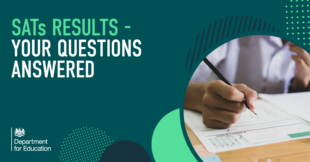
We want as many pupils as possible to leave primary school with the English and maths skills they need to meet their potential in secondary school.
That’s why we use national curriculum tests – commonly known as SATs - to help teachers understand which pupils need extra support and to support schools in helping their pupils catch up on the learning they missed during the worst of the pandemic.
We welcome the increase in reading attainment in this year’s KS2 results, despite the impact of the pandemic. This is a tribute to the hard work and dedication of teachers, pupils and parents in the incredibly challenging circumstances of the pandemic.
However, this year’s results also show a drop in the overall proportion of pupils meeting the expected standard in all three subjects (English reading, English writing and maths) at the end of key stage 2. Given the disruption pupils experienced during the pandemic, this overall drop is something we expected to see.
Here we answer your questions.
As a parent, how will I know what my child’s results are?
Your child’s school will inform you of the results of any national curriculum assessments they have undertaken by the end of the school year alongside comparative information on the results of pupils of the same age in the school and of those pupils nationally.
What do this year’s results show?
59% of pupils met the expected standard in all of reading, writing and maths, down from 65% in 2019
In reading, 74% of pupils met the expected standard, up from 73% in 2019.
In writing teacher assessments, 69% of pupils met the expected standard, down from 78% in 2019.
In maths, 71% of pupils met the expected standard, down from 79% in 2019.
72% percent of pupils met the expected standard in grammar, punctuation and spelling, down from 78% in 2019.
In science teacher assessments, 79% of pupils met the expected standard, down from 83% in 2019.
Why have results dipped?
Over the past three years pretty much everyone has been impacted by the pandemic, but different schools and pupils will have been impacted in different ways. We need to wait for more detailed statistics in September to say more.
But broadly, while it is disappointing to see the numbers of pupils achieving the expected standard in all three subjects go down, it is encouraging to see results in reading held up.
A decrease in attainment was also expected due to the pandemic, and children catching up faster in reading than other subjects was predicted by earlier research commissioned by the Government.
What does this mean for pupils?
All it means for pupils on an individual basis is that it will help their teachers and parents understand how pupils are doing in English, maths and science, and where they may need extra support. The test results also help inform their transition to secondary school to ensure they receive the right support once they start.
You say the dip is down to the effects of Covid – how are you helping pupils catch up?
Children who are behind in maths or English will receive timely identification of need, evidence-based targeted support, such as tutoring, to help them make progress and schools will keep parents updated on their child's progress
The National Tutoring Programme was launched in 2020 and provides schools with three routes to high quality subsidised tutoring - tuition partners, academic mentors, and school-led tutoring.
These tutors – who have all had robust high-quality training and safeguarding checks – can provide schools with additional capacity to support disadvantaged pupils who need extra help to catch up.
Following sector feedback, from next year, we will allocate all tutoring funding directly to schools. This will simplify the process and give schools the flexibility to arrange tutoring that exactly meets the needs of their pupils.
Do you still aim to improve literacy and numeracy in primary schools?
Literacy and numeracy are the building blocks of a world-class education. They unlock the learning, knowledge and skills that every child needs to succeed in later life.
In 2022, only 59% of children left primary school meeting the expected standard in reading, writing and maths.
We are rightly ambitious to build back better from this baseline and aim for 90% to meet the expected standard by 2030.
A second ambition for secondary schools aims to see the national average GCSE grade in both English language and maths increase from 4.5 in 2019 to 5 by 2030.
To help us achieve this, we announced a range of measures as part of our Schools White paper, including:
- Ofsted will inspect every school by 2025, including the backlog of ‘outstanding’ schools that haven’t been inspected for many years
- By 2030 all children will benefit from being taught in a school in, or in the process of joining, a strong multi-academy trust, which will help transform underperforming schools and deliver the best possible outcomes for children
- At least £100m to put the Education Endowment Foundation on a long-term footing so they can continue to evaluate and spread best practice in education across the country
- Introducing a new expectation of a 32.5-hour minimum school week for all mainstream state-funded schools to be delivered by September 2023 at the latest
These measures will help improve children's access to good quality education, regardless of their background, where they live or how the pandemic affected them.